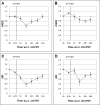Early assessment of tumor response to photodynamic therapy using combined diffuse optical and diffuse correlation spectroscopy to predict treatment outcome
- PMID: 28423634
- PMCID: PMC5386732
- DOI: 10.18632/oncotarget.15720
Early assessment of tumor response to photodynamic therapy using combined diffuse optical and diffuse correlation spectroscopy to predict treatment outcome
Erratum in
-
Correction: Early assessment of tumor response to photodynamic therapy using combined diffuse optical and diffuse correlation spectroscopy to predict treatment outcome.Oncotarget. 2019 Feb 22;10(16):1602. doi: 10.18632/oncotarget.26742. eCollection 2019 Feb 22. Oncotarget. 2019. PMID: 30899428 Free PMC article.
Abstract
Photodynamic therapy (PDT) of cancer involves the use of a photosensitizer that can be light-activated to eradicate tumors via direct cytotoxicity, damage to tumor vasculature and stimulating the body's immune system. Treatment outcome may vary between individuals even under the same regime; therefore a non-invasive tumor response monitoring system will be useful for personalization of the treatment protocol. We present the combined use of diffuse optical spectroscopy (DOS) and diffuse correlation spectroscopy (DCS) to provide early assessment of tumor response. The relative tissue oxygen saturation (rStO2) and relative blood flow (rBF) in tumors were measured using DOS and DCS respectively before and after PDT with reference to baseline values in a mouse model. In complete responders, PDT-induced decreases in both rStO2 and rBF levels were observed at 3 h post-PDT and the rBF remained low until 48 h post-PDT. Recovery of these parameters to baseline values was observed around 2 weeks after PDT. In partial responders, the rStO2 and rBF levels also decreased at 3 h post PDT, however the rBF values returned toward baseline values earlier at 24 h post-PDT. In contrast, the rStO2 and rBF readings in control tumors showed fluctuations above the baseline values within the first 48 h. Therefore tumor response can be predicted at 3 to 48 h post-PDT. Recovery or sustained decreases in the rBF at 48 h post-PDT corresponded to long-term tumor control. Diffuse optical measurements can thus facilitate early assessment of tumor response. This approach can enable physicians to personalize PDT treatment regimens for best outcomes.
Keywords: optical spectroscopy; photodynamic therapy; relative blood flow; tissue oxygenation; treatment response monitoring.
Conflict of interest statement
The authors have no conflicts of interest to declare in relation to this article.
Figures










References
-
- Andersson-Engels S, Klinteberg C, Svanberg K, Svanberg S. In vivo fluorescence imaging for tissue diagnostics. Phys Med Biol. 1997;42:815–24. - PubMed
-
- Berg K, Selbo PK, Weyergang A, Dietze A, Prasmickaite L, Bonsted A, Engesaeter BØ, Angell-Petersen E, Warloe T, Frandsen N, Høgset A. Porphyrin-related photosensitizers for cancer imaging and therapeutic applications. J Microsc. 2005;218:133–47. - PubMed
MeSH terms
Substances
LinkOut - more resources
Full Text Sources
Other Literature Sources

